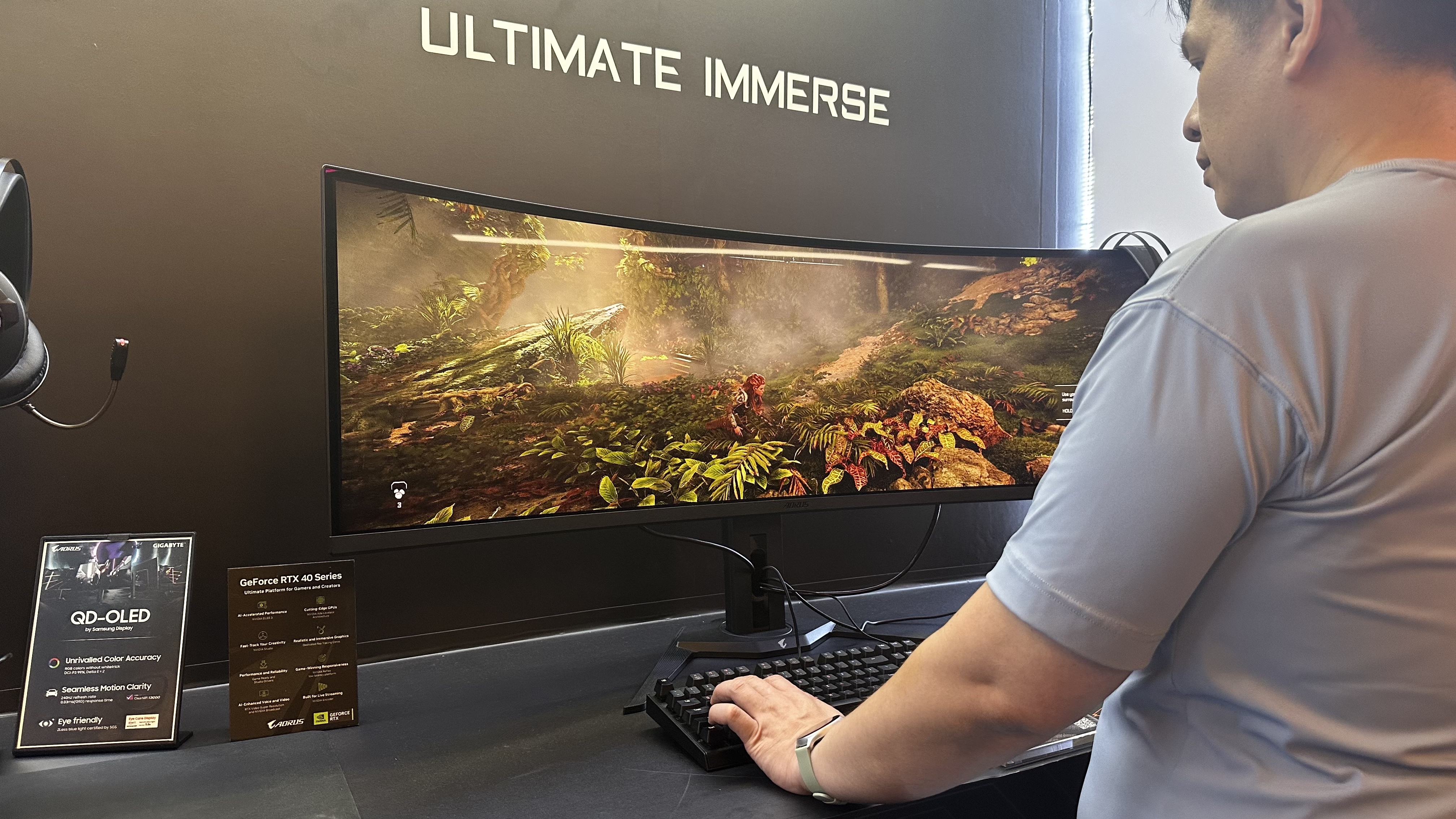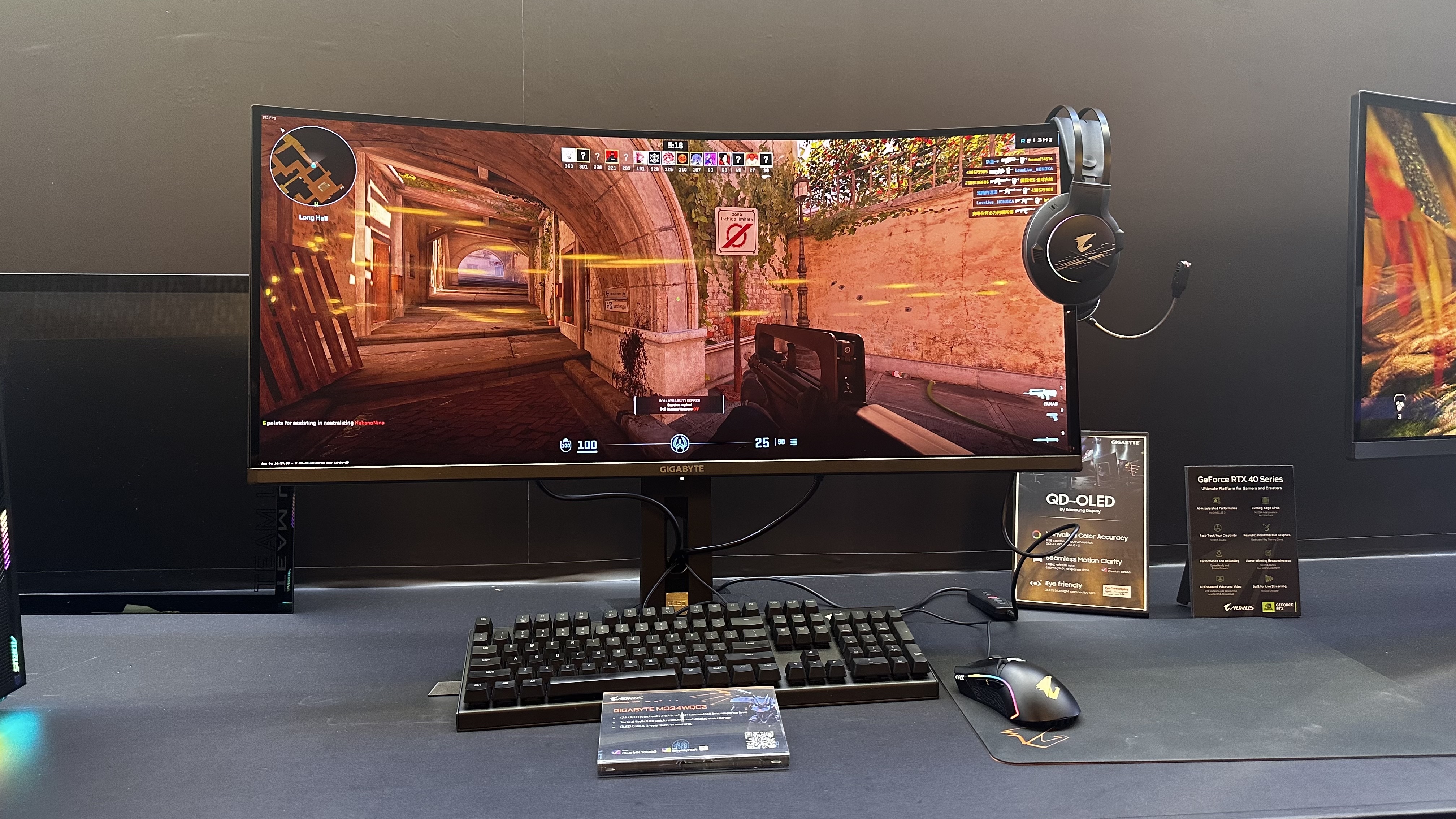This Gigabyte Aorus monitor makes a compelling case for QD-OLED gaming displays
QD-OLED monitors seem to be everywhere these days

One of the more interesting developments in monitor technology at CES in January and Computex in June this year is the expansion of QD-OLED panels.
QD-OLED is a sub-category of OLED display technology that uses quantum dots that emit color when receiving an electric current. Like OLED panels, QD-OLED displays are also incredibly vibrant and feature deep black shades, but QD-OLED panels can get even brighter than OLED displays. So seeing so many different QD-OLED monitors in the tradeshow circuit this year can only mean better display options for those who have the money to pay for a more expensive panel.
One of the newer options on the QD-OLED side is the Gigabyte Aorus CO49DQ gaming monitor. Boasting Vesa Display HDR TrueBlack 400, bright vivid colors, a 144Hz refresh rate, and 0.03 ms response time, the CO49DQ gaming monitor could end up as one of our best gaming monitors.
Gigabyte Aorus CO49DQ monitor: Pricing and configurations
There is only one configuration of the Aorus CO49QD monitor. For $1,099 you get a 49-inch DQHD (5,120 x 1,440) super ultrawide QD-OLED gaming monitor with 144Hz refresh rate and 0.03ms GTG response time.
The Aorus CO49DQ is available for purchase through Newegg.
Gigabyte Aorus CO49DQ monitor: Design
The Gigabyte Aorus CO49DQ has a minimalist V-shaped monitor stand, though it is VESA mount compatible if you’d like to fit it to an armature or alternative stand instead. As a super ultrawide monitor, it does have a pretty generous curve to the display panel. However, it isn’t a very severe curve so you have a bit of range on the viewing angle.
At 24.8 pounds, the CO49DQ is heavy, 18.3 pounds of that is the display, while the stand weighs 6.5 pounds. Measuring 47 x 22 x 10.29 inches with the stand, there's a good chance it will dominate your desk. However, if your desk can fit the monitor, you should still have enough space for all of your gaming accessories.
Get The Snapshot, our free newsletter on the future of computing
Sign up to receive The Snapshot, a free special dispatch from Laptop Mag, in your inbox.
Gigabyte Aorus CO49DQ monitor: Ports
There are plenty of ports on the Aorus CO49DQ monitor so you should have no problem connecting all of your gaming accessories straight to the monitor. The gaming monitor features two HDMI 2.1 ports, one DisplayPort 1.4 connection, one USB Type-C upstream port with power delivery up to 18W, two USB Type-A 3.0 downstream ports, one USB Type-A upstream port, and a 3.5mm audio jack.
However, if you need more ports we recently added a gaming docking station to our list of the best docking stations.
Gigabyte Aorus CO49DQ monitor: Display
If the Gigabyte Aorus CO49DQ monitor holds true to the standards set by other QD-OLED monitors, it will be one of the nicest gaming displays you can get your hands on. Gigabyte has rated the CO49QD as a Vesa Display HDR TrueBlack 400 panel with 99% coverage of the DCI-P3 color gamut and a refresh rate of 144Hz with a 0.03 ms response time.
Of course, we’ll need to wait until we get a review unit into our labs and tested with a colorimeter to confirm, but the technology does have a reputation for producing bright, vibrant displays for good reason.
Outlook

The Gigabyte Aorus CO49DQ monitor has a lot going for it, when it comes to providing some of the latest monitor tech to the gaming community. With a VESA HDR TrueBlack 400 rating, 0.03ms response time, 144Hz refresh rate, DQHD (5,120 x 1,440) resolution, and 99% DCI-P3 gamut coverage there is plenty to recommend this gaming monitor to your wishlist.
And while QD-OLED panels aren’t cheap, at $1,099 the CO49DQ gaming monitor isn’t the priciest out there. Of course, to determine just how well it holds up to its promises we will have to wait until we spend a bit more time with the monitor and run it through our benchmarks. But based on what we've seen so far, things are looking pretty good for this Aorus display.

A former lab gremlin for Tom's Guide, Laptop Mag, Tom's Hardware, and TechRadar; Madeline has escaped the labs to join Laptop Mag as a Staff Writer. With over a decade of experience writing about tech and gaming, she may actually know a thing or two. Sometimes. When she isn't writing about the latest laptops and AI software, Madeline likes to throw herself into the ocean as a PADI scuba diving instructor and underwater photography enthusiast.
